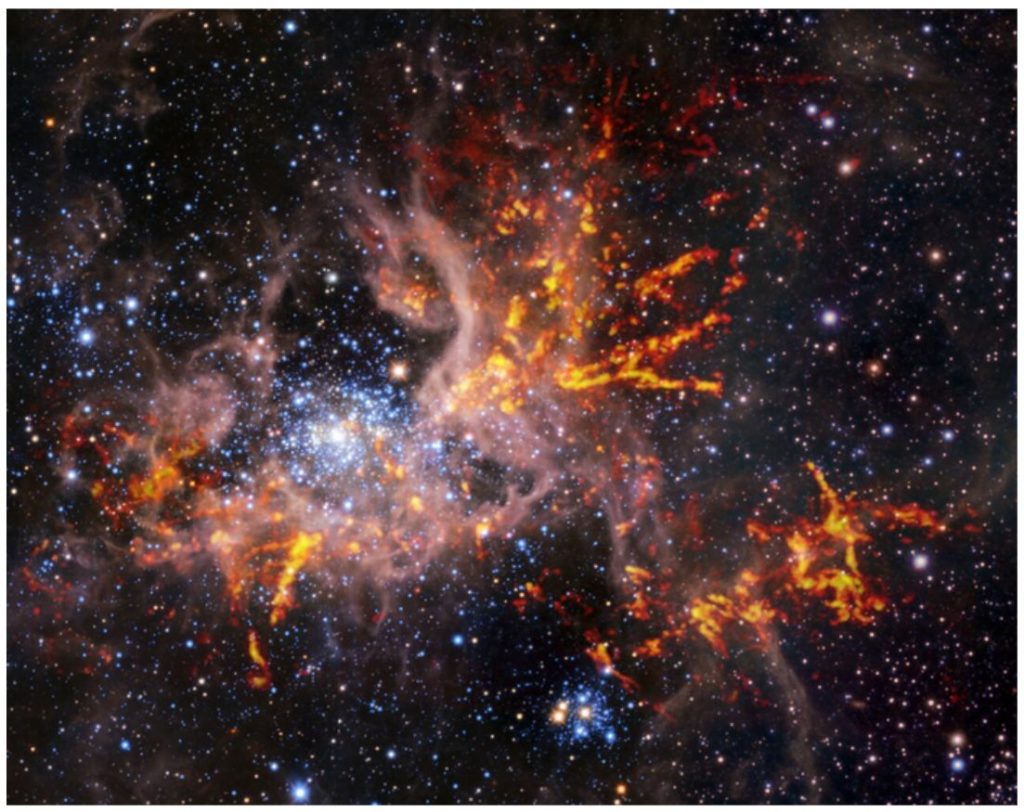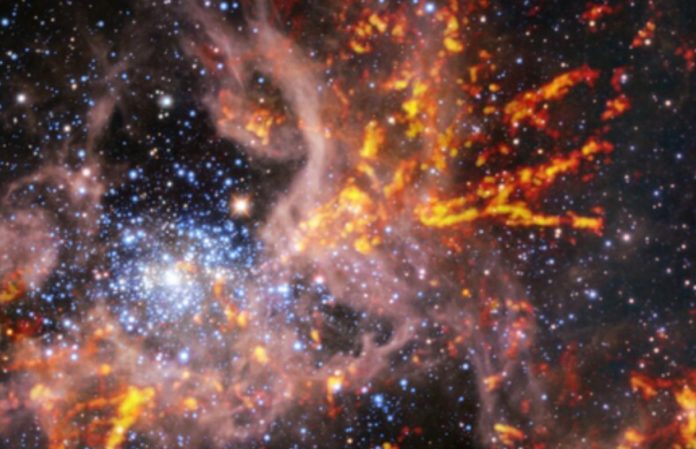Astronomers say this web-like structure could be fragments of the leftovers of once-larger clouds ripped by the huge energy emitted by young and massive stars, a phenomenon known as feedback.
Professor Tony Wong, who led the study published in The Astrophysical Journal says: “These fragments may be the remains of once-larger clouds that have been shredded by the enormous energy being released by young and massive stars, a process dubbed feedback.”
Astronomers initially believed that the gas in these regions would be too scarce and swamped by this turbulent feedback for gravity to draw it together and generate new stars. However, the new data also reveal far thicker filaments where the gravity still plays a role.
According to Professor Wong, these findings “imply that even in the presence of very strong feedback, gravity can exert a strong influence and lead to a continuation of star formation.”

The Tarantula Nebula, located in the Large Magellanic Cloud, a satellite galaxy of our own Milky Way, is one of the brightest and most prolific star-forming regions in our galactic neighborhood, sitting around 170 000 light-years away from Earth. The region’s core contains some of the most massive stars known, with a handful exceeding 150 times the mass of our Sun, making it ideal for researching how gas clouds collapse under gravity to generate new stars.
“What makes 30 Doradus unique,” according to co-author Guido De Marchi, “is that it is close enough for us to study in detail how stars are forming, and yet its properties are similar to those found in very distant galaxies, when the Universe was young.”
“Thanks to 30 Doradus, we can study how stars used to form 10 billion years ago when most stars were born.”
While much past research on the Tarantula Nebula has concentrated on its center, astronomers have long suspected that enormous star creation occurs elsewhere. The scientists used high-resolution observations over a vast area of the nebula to gain a better understanding of the process. They used ALMA to measure the light emitted by carbon monoxide gas. This allowed them to trace the nebula’s enormous, cold gas clouds that collapse to give birth to new stars, as well as how they alter as the young stars discharge massive quantities of energy.
“We were expecting to find that parts of the cloud closest to the young massive stars would show the clearest signs of gravity being overwhelmed by feedback,” Wong explains. “We found instead that gravity is still important in these feedback-exposed regions — at least for parts of the cloud that are sufficiently dense.”
The new ALMA data is layered on a prior infrared image of the same location collected with ESO’s Very Large Telescope (VLT) and ESO’s Visible and Infrared Survey Telescope for Astronomy, which displays brilliant stars and light pinkish clouds of hot gas. The Tarantula Nebula’s gas clouds have a characteristic, web-like shape, which gives the nebula its spidery name. The new ALMA data include of the image’s vivid red-yellow streaks, which are extremely cold and dense gas that could one day collapse to become stars.
The new study provides precise information on how gravity acts in the star-forming regions of the Tarantula Nebula, but it is far from complete. “There is still much more to do with this fantastic data set, and we are releasing it publicly to encourage other researchers to conduct new investigations,” Wong says.
Image Credit: ESO
You were reading: Astonishing Image Captures A Unique Web-like Structure Of The Gas Clouds
